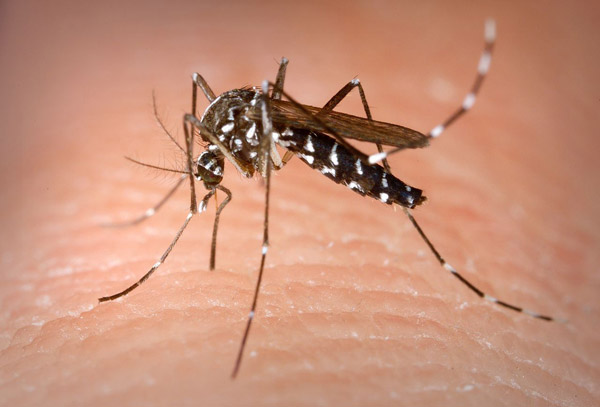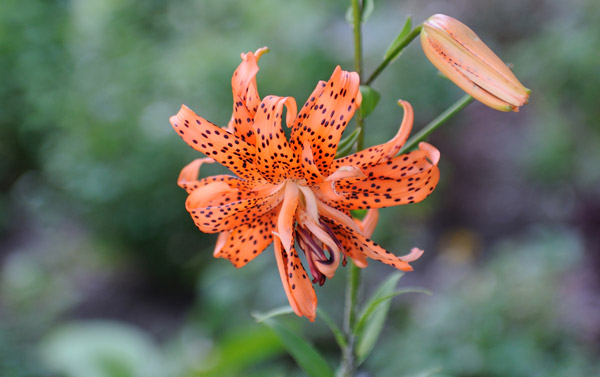
The Asian tiger mosquito has been spotted in Battery Park City as well as in other places in New York City.
Asian tiger mosquitoes invade BPC
The doormen at 377 Rector Place are used to swatting mosquitoes in the summer time, but this year, two of them mentioned that they are getting bitten by a particularly nasty mosquito with a striking black and white pattern on its body. It’s the Asian tiger mosquito (Aedes albopictus) and it is a nasty one. It is aggressive and is a vector for several viral diseases including West Nile virus, yellow fever, St. Louis encephalitis, dengue fever and Chikungunya fever, whose symptoms include fever, severe joint pain, achiness, headaches, nausea and fatigue. Sometimes this fever is fatal, but mostly it produces severe and persistent pain in the small joints of the hands and feet.
Although the Asian tiger mosquito has transmitted these diseases elsewhere in the world, thus far this mosquito has not caused the diseases to crop up in N.Y.C. But health officials and scientists say it could happen, and they are concerned.
The Asian tiger mosquito is native to the tropical and subtropical areas of Southeast Asia. It was introduced into the United States in a shipment of tires that arrived in Houston, Texas in 1985.
Since then, it has been making its way northward, abetted by climate change, which produces the warmer temperatures that it prefers. For around a decade, it has been common in New Jersey. Now it has crossed the Hudson River into New York City, and has also been discovered in 36 states. Because of its location, Battery Park City would be one of its first stops.
“I have noticed them in my neighborhood as well [as Battery Park City],” said Tessa Huxley, the executive director of the Battery Park City Parks Conservancy and a Lower East Side resident.
The Asian tiger mosquito thrives in urban settings and is difficult to eradicate because it can breed in even the smallest amount of standing water — as small as a bottle cap. Unlike many other mosquitoes, which are mainly active at dawn and dusk, this mosquito feeds during the day. Only the females suck blood, which they need to nourish their developing eggs. Once they find a host, they are likely to bite again and again before they are finished.
“The Battery Park City Parks Conservancy staff has instructions to remove any standing water they find in the parks and open spaces that we maintain,” said Huxley. “As you can imagine, there are depressions in the pavement in any number of places and our staff, both horticulture and maintenance, are asked to sweep the water out of those places in order to reduce opportunities for any type of mosquito to breed. They are reminded to do so on a regular basis.”
Huxley said that it was also essential for building staffs to keep after all standing water. “I am afraid that there are probably multiple puddles in the rooftops of all the buildings,” Huxley said, “and ‘out of sight is out of mind.’ In addition, I am sure that some building courtyards experience the same problems as we have with small depressions in the paving.”
Asian tiger mosquitoes do not fly very well. In fact, they will not travel more than 200 yards from where they breed. However, people and birds do travel long distances. If an Asian tiger mosquito bites an infected person or bird, it can transmit viruses to the next person it bites.
A study published by Cornell University estimated that “there is a high probability of a Chikungunya outbreak if a single infected person arrives in New York in July or August and is bitten by an Asian tiger mosquito.”
There is no vaccine for this disease and no cure. The Asian tiger mosquitoes are attracted to dark clothing and typically bite legs and feet. Insect repellents containing DEET are said to be helpful in keeping the mosquitoes away.
Winter Garden gets new trees
The palm trees in the Winter Garden have grown too tall for the space and have to be replaced. Workmen began to remove the old trees on Aug. 12 and expect to be finished with that part of the job by the end of the week.
The trees (Washingtonia robusta) are around 60 feet tall. They have grown spindly and show signs of curvature and twisting. They were planted in the Winter Garden in September 2002, when it reopened after having been destroyed on 9/11. Along with the Winter Garden’s grand, marble stairway, the palm trees epitomized resurgence after the World Trade Center attack. For Battery Park City residents and workers, the Winter Garden became a favored place to meet and rest.
Sixteen new trees, which will be planted between Aug. 19 and 23, are the same species as the old ones, but will be around 35 feet tall. The work will be done during the evening hours and should be completely finished by Saturday, Aug. 24.
“When palm trees are outside, wind makes the trunks strong,” said Melissa Coley, a spokesperson for Brookfield Office Properties, owner of the Winter Garden. The Winter Garden palm trees lacked this advantage, of course.
The replaced trees will be mulched and sent to local hospitals for use in serenity gardens.
East Indian family dance and storytelling
Two distinguished performers will present Indian music and storytelling in Battery Park City on Saturday, Aug. 17. “We have a delightful day planned,” said Abby Ehrlich, director of programming for the Battery Park City Parks Conservancy, which is sponsoring both events.
Sunita S. Mukhi will tell Indian stories in Teardrop Park at 11 a.m. Her recitation, called “Monkeys, Mangoes and Magic,” is for all ages. Mukhi produces Asian-American programming at SUNY Stony Brook’s Charles B. Wang Center. She is also a performer, director, choreographer and poet. She is of South Asian background, although she was born and raised in Manila, the Philippines.
Teardrop Park is between Warren and Murray Streets, off River Terrace.
Esplanade Plaza on the south side of North Cove Marina will be the place to be from 6:30 p.m. to 8 p.m., when DJ Rekha accompanied by drummers and dancers shows what East Indian bhangra is all about. This lively music, a combination of traditional music of the Punjab region of India and western music, originated in London in the 1980s, where Rekha was born.
Rekha has performed at SOB’s on Varick St., at Central Park’s SummerStage and at Prospect Park’s Celebrate Brooklyn. She has lectured on South Asian-American pop culture at New York University.
This will be the last of this season’s family dances sponsored by the Parks Conservancy. Each one showcases a different ethnic music tradition, with leaders who demonstrate the dance steps. Everyone can dance, with or without partners. For those who just wish to watch and listen, the music is always great.
Both events are free.

Tiger lilies are blooming on the Battery Park City esplanade.
Battery Park City in bloom
Many kinds of lilies are now blooming in Battery Park City. Among the most flamboyant are tiger lilies (Lilium flore pleno) displaying speckled orange flowers near Albany Street on the esplanade.
These lilies are native to eastern Guam, China, Korea and Japan. In China, they were cultivated for food.
The great 18th-century botanist Carl Linnaeus came up with the name “Lilium” for this genus of flowers. The Latin name has a distinguished linguistic pedigree. It was derived from a Greek word, “leírion,” which, in turn, emanated from a word for “flower” used in ancient Egypt. Both the Greek and Egyptian words may be the remainders of a language once used in the Eastern Mediterranean and now forgotten.
Lilies figure prominently in the Bible (“I am the Rose of Sharon and the lily of the valley” and “like a lily among the thorns” in the “Song of Solomon”), but it’s probable that the lily to which the Old Testament refers is not the same as the flowers now known by that name. In the New Testament, they were associated with the Virgin Mary and her purity.
BY TERESE LOEB KREUZER
































